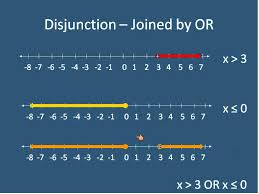Overview
Inequalities can be graphed along the number line by solving the inequality and then graphing it. Conjunctions are true when both statements of an inequality are true. Disjunctions are true when either one or both statements of an inequality are true. Both conjunctions and disjunctions can form the basis for truth tables.
Review of Inequalities and the Number Line
Inequalities are expressed by relationships between numbers that are less than <, greater than>, less than or equal to≤ or greater than or equal to≥. When just one variable is used, the sentence can be represented on the number line. Suppose that a student wanted to show numbers greater than or equal to -40 on the number line. That student might write a sentence such as x is ≥ -40. Notice that the circle at -40 is filled in as the number -40 makes the inequality a true statement.
Conjunctions
A conjunction is a set of two statements joined by the word “and”, so that both statements must be true. In other words, the points on a number line that are solutions of both inequalities are the solution set. For example, suppose that one inequality is x ≥4 and another inequality is x> 3 +6. The numbers that will be in common are the points larger than 9, but not including 9. Although 9 is greater than 4, it is not included in the second inequality statement.
Disjunctions
A disjunction is a set of two statements joined by the word “or”, so that both statements could be true, or only one statement could be true. Suppose one sentence is x> 3 and the other sentence is x ≤ 0. The points that make that statement true are either those that are greater than 3 or those that are less than or equal to 0.
Truth Tables
Truth tables are another way of organizing statements, and are part of logic and a form of math called discrete math. In a conjunction, a statement is true only if both statements are true. For example, the statement “two is a prime number and three is an odd number“ is true because both parts of the statement is true. However, the statement “two is an odd number and three is a prime number” is false because the first statement is false. Similarly, “Four is an even number and six is an odd number” is false because the second statement is false. “Seven is an even number and four is an odd number” is false because both statements are false.
Interested in math tutoring services? Learn more about how we are assisting thousands of students each academic year.
SchoolTutoring Academy is the premier educational services company for K-12 and college students. We offer tutoring programs for students in K-12, AP classes, and college. To learn more about how we help parents and students in Winnipeg, Manitoba: visit: Tutoring in Winnipeg, Manitoba



